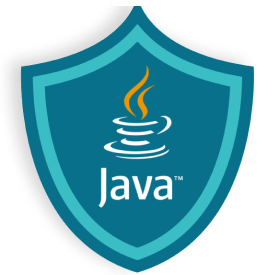26
DecMicroservices in Java - A Detailed Guide
Microservices in Java is an architectural style where large Java-based applications are broken down into smaller, independent services that can be developed, deployed, and scaled independently. It is widely used for building scalable, maintainable, and efficient applications.
In this java tutorial,you will be able to know about Java Microservices, Core Concepts of Microservices Architecture, Why Java for Microservices Development, Key Java Frameworks for Microservices, Implementing a Java Microservice (Step-by-Step), Deploying Java Microservices, Monitoring and Observability in Java Microservices, Best Practices for Java Microservices. Start your Java journey today with our Free Java Certification Course. Register now!
What Are Java Microservices?
Java Microservices is an architectural approach where a large Java application is broken into smaller, independent services to build loosely coupled, independently deployable, data layers applications. Each service runs in its own process, handles a specific business function, and communicates with others via lightweight APIs (usually HTTP/REST or messaging queues).
This design follows the microservices architecture, allowing services to be developed, deployed, and scaled independently.
Microservices vs. Monolithic Architecture
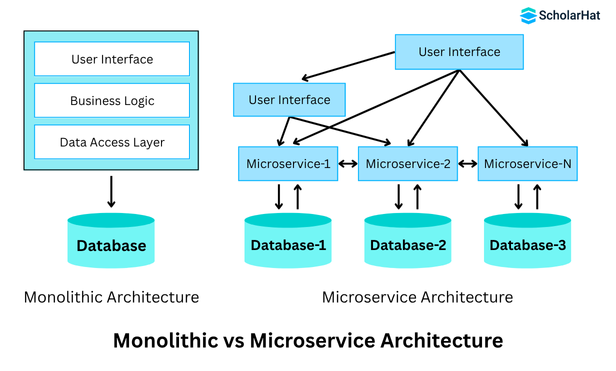
Key Characteristics of Java Microservices
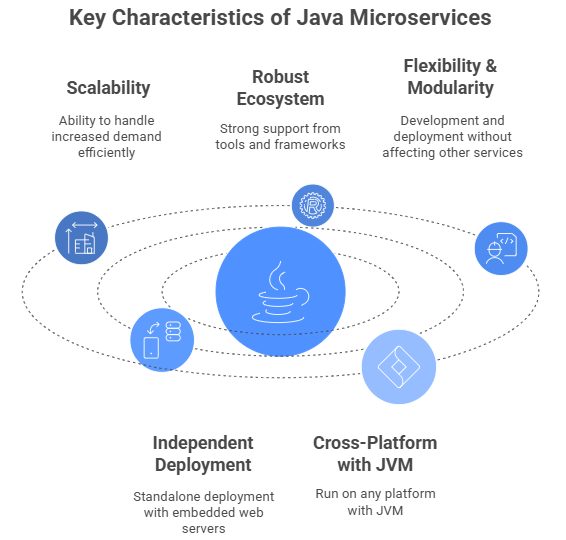
1. Scalability
- Java is ideal for building scalable microservices.
- With tools like Spring Boot microservices, each service can be scaled independently based on workload, allowing your application to handle increased demand efficiently.
2. Robust Ecosystem
- Java’s ecosystem is a major strength for microservices development.
- Tools and frameworks that make Java powerful include: Spring Boot, Spring Cloud, Java EE/ Jakarta EE, Hibernate /JPA, Maven /Gradle
3. Flexibility & Modularity
- Microservices in Java are loosely coupled, meaning they can be developed, updated, deployed, and even replaced without affecting other services.
- This modularity ensures higher development speed and easier maintenance.
4. Independent Deployment
- Using Spring Boot, developers can package each microservice as a standalone .jar file with an embedded web server (like Tomcat or Jetty). This makes deployment straightforward—no need for external servers.
- Each microservice can run and evolve independently, simplifying CI/CD pipelines.
5. Cross-Platform with JVM
- Java applications run on the Java Virtual Machine (JVM), which means once you build it, it can run on any platform—Linux, Windows, or macOS—offering maximum flexibility for deployment.
Java Microservices vs. SOA
| Aspect | Java Microservices | Service-oriented architecture (SOA) |
| Architecture Style | It is general architecture that takes large number of services and break down into small services or shareable component. | It is a huge collection of services in which services communicate with each other. |
| Approach | It works on Share-little-as-promise approach. | It works on Share-as-much-as-possible approach. |
| Protocol | It supports HTTP/REST lightweight protocol. | It supports various multiple protocol. |
| Database | It uses non-relational database (modern relational databases). | It uses traditional database. |
| Technology Stack | Spring Boot, Spring Cloud, Docker, Kubernetes (Java-based stack) | Java EE, SOAP, ESB (Enterprise Service Bus), WSDL |
| Best for | It is better suited for the smaller and well portioned, web-based system. | It is better for a large and complex business application environment. |
When to Use Java Microservices Over SOA ?
- You need independent deployment and scalability
- You're building cloud-native or containerized apps
- Fast development and agile delivery is a priority
- You prefer REST or event-driven communication
- You want flexible tech stacks (polyglot support)
- You require better fault isolation and maintainability
Challenges in Building Java Microservices
Building Java microservices brings flexibility and independent scalability, but also demands strong architecture, tooling, and DevOps maturity to handle distributed complexity.
Why Choose Java for Microservices?
Strengths of Java in Microservices
- Mature Ecosystem:Java offers a vast collection of libraries, frameworks, and tools specifically designed for scalable microservices development.
- Spring Boot Microservices Support: Java’s Spring Boot framework simplifies microservice creation with features like embedded servers (Tomcat, Jetty), auto-configuration, and quick deployment.
- Platform Independence (JVM): Java code runs on any operating system via the Java Virtual Machine, making microservices highly portable.
- Robust Frameworks: Java supports powerful frameworks like Spring Cloud, Jakarta EE, and Hibernate, enabling secure and efficient development
- Seamless Integration with DevOps Tools: Java microservices easily integrate with Docker, Kubernetes, Jenkins, Prometheus, and other modern DevOps tools.
Java vs. Other Languages for Microservices
| Criteria | Java | Node.js | Python | Go (Golang) |
| Performance | High performance with mature threading model | Fast for I/O, single-threaded | Slower for concurrency-heavy tasks | Extremely fast and lightweight |
| Scalability | Excellent, widely used in enterprise-grade systems | Good, suitable for lightweight apps | Moderate, can be complex for scaling | Excellent, built for cloud-native apps |
| Ecosystem | Rich ecosystem (Spring Boot, Spring Cloud, etc.) | Large npm ecosystem | Strong ML/data science libraries | Growing, with cloud-native tools |
| Best Use Cases | Java is ideal for enterprise applications, secure APIs, and large-scale Spring Boot microservices. | Node.js suits real-time apps (e.g., chat, streaming) | Python is great for ML/data services. | Go is preferred for performance-critical, containerized microservices in the cloud. |
Key Java Frameworks for Microservices

1. Spring Boot Microservices
Features of Spring Boot Microservices
- Auto-Configuration: Auto-configuration in Spring Boot simplifies the process of setting up new development environments. Reduces boilerplate code and simplifies setup.
- Embedded Servers:Comes with embedded Tomcat, Jetty, or Undertow, so you don’t need to deploy to an external server.Each microservice runs independently.
- RESTful Web Services Support:Easily build REST APIs using @RestController, @RequestMapping, etc. Perfect for inter-service communication.
- Spring Cloud Integration: Works seamlessly with Spring Cloud for: Service discovery (Eureka), API Gateway (Spring Cloud Gateway), Config server, Circuit breaker (Resilience4j)
Use case of spring boot microservices
- E-commerce Platforms: Separate services for product catalog, user management, cart, order processing, and payments.
- Banking and Financial Systems:Services for account management, transaction processing, fraud detection, and reporting.
- Online Streaming Services: Handle services like media metadata, content delivery, user profiles, subscriptions, and recommendations.
2. Micronaut for Lightweight Java Microservices
Features of Micronaut
- Fast Startup Time: Because ofAOT compilation, Micronaut applications start almost instantly — ideal for serverless and containerized environments.
- Low Memory Footprint: Uses less memory than traditional Java frameworks, perfect for microservices running on limited-resource environments.
- Dependency Injection (DI):Built-in compile-time dependency injection (no runtime reflection), leading to better performance and easier debugging.
- Reactive & Non-Blocking I/O: Supports reactive programming with RxJava or Project Reactor, enhancing performance under high concurrency.
- Cloud-Native Ready: Works well with Docker, Kubernetes, GraalVM, and serverless platforms like AWS Lambda.
Common Use Cases for Micronaut
- Serverless Application: Its lightning-fast cold start time makes Micronaut a strong choice for AWS Lambda or other FaaS platforms.
- Lightweight Microservices: Ideal for microservices that need to be small, isolated, and start quickly in containers or edge environments.
- API Gateways & Edge Services: Due to fast I/O handling and low overhead, Micronaut is great for building high-performance API gateways.
- Event-Driven Systems: With built-in messaging support (Kafka, RabbitMQ), it's suitable for reactive, event-driven microservice architectures.
- Testable Services: Its simplified dependency injection and startup make it a good fit for test-driven microservices development.
3. Quarkus for Cloud-Native Java Microservices
Quarkus is a Kubernetes-native Java stack tailored for GraalVM and OpenJDK HotSpot, built using the best of breed Java libraries and standards.Quarkus aims to make Java a leading platform in Kubernetes and serverless environments, offering developers a unified reactive and imperative programming model.
Features of Quarkus:
- Unified Reactive & Imperative Programming:Supports both reactive (non-blocking) and traditional imperative programming styles, giving developers flexibility based on workload needs.
- Hot Reload:Developer joy is central—Quarkus provides fast hot reload during development, speeding up the feedback loop and boosting productivity.
- GraalVM Native Image Support:Compile applications to native executables for ultra-fast startup and minimal memory consumption—ideal for scale-to-zero or edge deployments.
- Built-in Cloud-Native Features:Native support for Kubernetes, OpenShift, Docker, Prometheus, Open Telemetry, and more—no extra configuration required.
Use Cases for Quarkus
- Cloud-Native Microservices:Perfect for microservices deployed on Kubernetes/OpenShift with fast scale-up/scale-down needs.
- Event-Driven Architectures: Excellent for messaging systems using Kafka, AMQP, or reactive APIs.
- Serverless Applications: GraalVM native images make Quarkus an ideal choice for functions-as-a-service (FaaS) platforms like AWS Lambda.
- Edge & IoT Microservices: Lightweight deployment and low resource usage make it suitable for edge computing.
4. Jakarta EE for Enterprise Java Microservices
Features of Jakarta EE for Microservices:
- RESTful APIs with JAX-RS – Easily build RESTful web services for microservices using Jakarta EE’s built-in JAX-RS API.
- Dependency Injection with CDI – Enables loose coupling and better modularization using Contexts and Dependency Injection.
- MicroProfile Integration – Enhances Jakarta EE with cloud-native features like config, health checks, metrics, JWT auth, and fault tolerance.
- Portability and Vendor-Neutrality – Jakarta EE applications run on multiple compatible servers (e.g., Payara, Open Liberty), ensuring flexibility and reduced vendor lock-in.
Use cases of Jakarta EE for microservices
- Modernizing Legacy Applications: Transform traditional Java EE monoliths into modular, maintainable microservices using Jakarta EE standards.
- Cloud-Native Enterprise Services: Build cloud-ready microservices with support for REST (JAX-RS), security, and configurations through MicroProfile.
- Rapid API Development: Easily expose business logic as RESTful services using Jakarta EE’s JAX-RS and dependency injection (CDI).
- Enterprise-Grade Security & Transactions: Leverage Jakarta EE’s built-in support for security, transactions, and scalability in microservices environments.
Setting Up the Java Microservices Development Environment
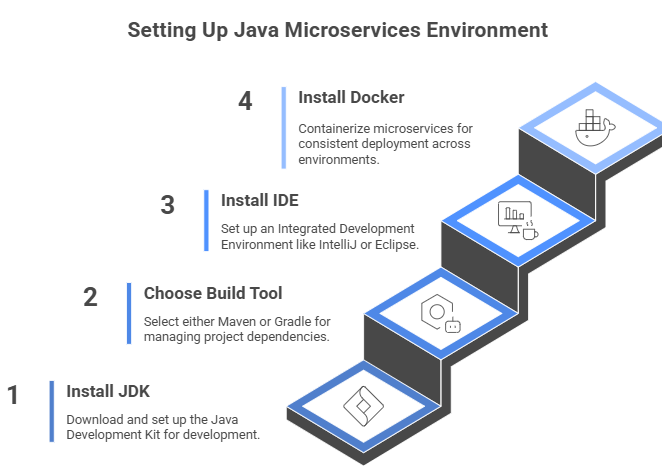
1. Install Java Development Kit (JDK)
- Recommended: JDK 17 or JDK 21 (LTS versions)
- Download: Oracle JDK or OpenJDK
- Set JAVA_HOME environment variable
- Verify installation: java -version
2. Choose a Build Tool: Maven or Gradle
Apache Maven
- XML-based (pom.xml)
- Common in enterprise Java
- Install from: https://maven.apache.org/download.cgi
- Verify: mvn -v
Gradle
- Groovy/Kotlin-based (build.gradle)
- Faster, modern build tool
- Install from: https://gradle.org/install/
- Verify: gradle -v
3. Install an IDE (Integrated Development Environment)
IntelliJ IDEA (Recommended)
- Better support for Spring Boot
- Smart code assistance and live templates
- Download IntelliJ
Eclipse IDE
- Lightweight and free
- Requires Spring Tools plugin for Spring Boot\
- Download Eclipse
4. Install Docker
Use Docker to containerize your microservices for consistent deployment. Docker helps in :
- Build a Docker image for each microservice
- Run microservices on any OS
- Use Docker Compose for managing multiple services
- Install Docker:https://www.docker.com/products/docker-desktop
- Verify: docker --version
Building a Sample Java Microservice with Spring Boot
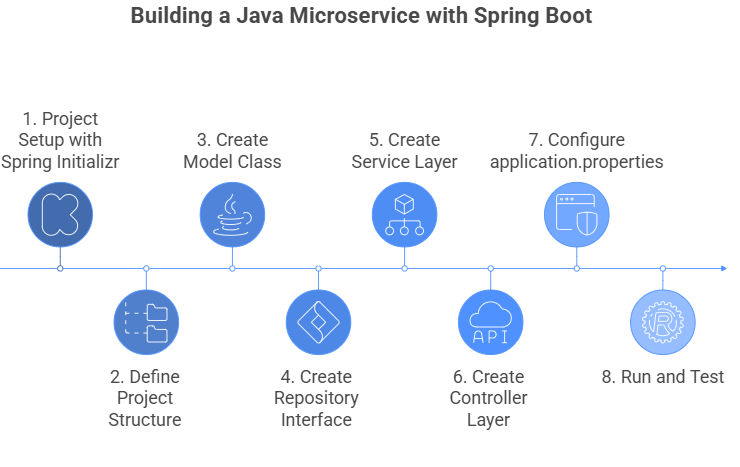
Step 1: Project Setup with Spring Initializr
You begin by creating a new Spring Boot project. The easiest way is to use the Spring Initializr, which allows you to select:
- Dependencies: Spring Web, Spring Boot DevTools, Spring Data JPA, H2/MySQL, Spring Boot Actuator
- Choose Maven or Gradle as the build tool.
- This generates a ready-to-run project with the basic structure.
Step 2: Define the Project Structure
Spring Boot follows a specific folder structure. You typically divide your code into:
- controller → Handles HTTP requests
- model → Defines your database entity (Java class)
- repository → Handles data access (via JPA)
- service → Business logic
This makes your code clean and maintainable.
src/
├── main/
│ ├── java/com/example/service
│ │ ├── controller/
│ │ ├── model/
│ │ ├── repository/
│ │ ├── service/
│ ├── resources/
│ ├── application.properties
Step 3: Create Model Class
In Java, this is a POJO (Plain Old Java Object) annotated with @Entity. For example:
@Entity
public class Product {
@Id
@GeneratedValue
private Long id;
private String name;
private double price;
// Getters & Setters
}
This class maps to a database table where you store products.
Step 4: Create Repository Interface
Spring Data JPA makes it easy to perform database operations using interfaces. You don’t need to write SQL queries—Spring handles it automatically.
@Repository
public interface ProductRepository extends JpaRepository {}
Step 5: Create Service Layer
This is where you write business logic—like fetching all products or saving a new one. It’s a middle layer between the controller and database.
@Service
public class ProductService {
@Autowired
private ProductRepository repo;
public List getAll() {
return repo.findAll();
}
public Product save(Product p) {
return repo.save(p);
}
}
Step 6: Create Controller Layer
The controller exposes your microservice's API endpoints. This allows users or other services to interact with your microservice via HTTP requests.
@RestController
@RequestMapping("/products")
public class ProductController {
@Autowired
private ProductService service;
@GetMapping
public List getAll() {
return service.getAll();
}
@PostMapping
public Product add(@RequestBody Product p) {
return service.save(p);
}
}
Step 7: Configure application.properties
You configure things like port number and database connection here:
properties
server.port=8081
spring.datasource.url=jdbc:h2:mem:testdb
spring.datasource.driver-class-name=org.h2.Driver
spring.datasource.username=sa
spring.datasource.password=
spring.jpa.database-platform=org.hibernate.dialect.H2Dialect
Step 8: Run and Test
Testing Java Microservices
Testing Java microservices involves multiple strategies to ensure reliability, scalability, and correctness. Here's a breakdown of the key types of testing involved in Java-based microservices using frameworks like Spring Boot.
Unit Testing Java Microservices with JUnit
Example: Unit Testing a Service Class with JUnit
@Service
public class ProductService {
@Autowired
private ProductRepository repo;
public Product getProductById(Long id) {
return repo.findById(id).orElseThrow(() -> new RuntimeException("Product not found"));
}
}
ProductServiceTest.java
@ExtendWith(MockitoExtension.class)
public class ProductServiceTest {
@Mock
private ProductRepository repo;
@InjectMocks
private ProductService service;
@Test
void testGetProductById() {
Product p = new Product(1L, "Phone", 1000.0);
when(repo.findById(1L)).thenReturn(Optional.of(p));
Product result = service.getProductById(1L);
assertEquals("Phone", result.getName());
}
}
Benefits of Unit Testing:
- Fast feedback during development.
- Helps catch logic bugs early.
- Ensures isolated components work properly
Integration Testing
Integration testing verifies that multiple components (e.g., database, REST API) of your microservice work together correctly. Unlike unit tests, which test in isolation, integration tests validate the complete flow of your application.
Setup for Integration Testing with Testcontainers
Testcontainers is a Java testing library that spins up real Docker containers for your dependencies (databases, queues, etc.) during tests. This makes your tests more realistic and reliable.
Test Code:
@Testcontainers
@SpringBootTest
public class ProductIntegrationTest {
@Container
static PostgreSQLContainer postgres = new PostgreSQLContainer<>("postgres:15")
.withDatabaseName("testdb")
.withUsername("user")
.withPassword("pass");
@DynamicPropertySource
static void dbProperties(DynamicPropertyRegistry registry) {
registry.add("spring.datasource.url", postgres::getJdbcUrl);
registry.add("spring.datasource.username", postgres::getUsername);
registry.add("spring.datasource.password", postgres::getPassword);
}
@Autowired
private TestRestTemplate restTemplate;
@Test
void testCreateProduct() {
Product product = new Product(null, "Laptop", 1200.0);
ResponseEntity response = restTemplate.postForEntity("/products", product, Product.class);
assertEquals(HttpStatus.OK, response.getStatusCode());
}
}
Communication in Java Microservices
1. Synchronous Communication:
- Services communicate in real-time, waiting for a response before proceeding.
- This pattern is often used with protocols such as HTTP/HTTPS through RESTful APIs or gRPC, making it suitable for operations that need immediate feedback like fetching user details or processing payments.
2. Asynchronous Communication:
- Services interact without waiting for an immediate response, improving system scalability and decoupling.
- It is commonly implemented using message brokers like RabbitMQ, Kafka, or AWS SQS.
3. Message Brokers:
- Message brokers like Apache Kafka, RabbitMQ, and AWS SQS/SNS facilitate asynchronous communication by managing message queues.
- These tools enable services to send and receive messages independently, helping to ensure fault tolerance and smooth data flow in distributed systems.
4. Service Discovery:
- In dynamic environments where services scale up and down, service discovery tools (e.g., Consul, Eureka) help services find and communicate with each other.
- This enables better load distribution, automatic failover, and easier scaling in cloud-native environments.
5. Load Balancing:
- Load balancing distributes incoming client requests across multiple instances of a service to maintain performance and reliability.
- Tools like NGINX, HAProxy, or cloud-native solutions handle this.
6. API Gateway:
- An API Gateway acts as a centralized entry point for all client requests.
- It routes requests to appropriate services and handles cross-cutting concerns like authentication, rate limiting, logging, and request transformation.
- Examples include Spring Cloud Gateway, Kong, and AWS API Gateway.
Deploying Java Microservices
1. Containerization with Docker
To deploy Java microservices efficiently, each service is packaged as a Docker container. This ensures consistency across development, testing, and production environments.
- Each microservice includes its code, runtime (e.g., JDK), libraries, and dependencies.
- Example: A Dockerfile can be used to build an image for a Spring Boot microservice.
2. Container Orchestration with Kubernetes
For managing and scaling containers, tools like Kubernetes (K8s) are used.
- Handles auto-scaling, self-healing, rolling updates, and service discovery.
- Microservices are deployed as Pods grouped into Deployments.
- Expose services using Kubernetes Services (ClusterIP, NodePort, or LoadBalancer).
3. CI/CD Pipelines
To automate testing and deployment, Continuous Integration and Continuous Deployment (CI/CD) pipelines are essential.
- Tools: Jenkins, GitHub Actions, GitLab CI, CircleCI.
- Steps include: Build → Test → Package → Dockerize → Deploy
- Helps maintain a reliable, repeatable deployment process.
Monitoring and Observability in Java Microservices
1. Centralized Logging
In a microservices architecture, each service runs independently—often across different containers or nodes. It's critical to collect logs centrally to debug issues effectively.
- Use tools like ELK Stack (Elasticsearch, Logstash, Kibana) or Fluentd + Loki + Grafana.
- Logs should include timestamps, service names, trace IDs, and error levels.
- Helps trace problems across services and analyze patterns or failures.
2. Metrics Collection
- Use libraries like Micrometer with Spring Boot to expose metrics.
- Collect data such as CPU usage, memory consumption, thread counts, request count, and response time.
- Tools like Prometheus scrape metrics and store time-series data, which can be visualized in Grafana dashboards.
3. Distributed Tracing
Tracing allows you to follow a request across multiple services, identifying bottlenecks and failures.
- Use tools like Jaeger or Zipkin.
- Inject trace IDs into requests and propagate them across services.
- Helps visualize request flows and pinpoint performance issues.
Best Practices for Java Microservices
1. Design Services Around Business Capabilities
Each microservice should represent a specific business function (e.g., user management, payment processing).
- Keeps services small, focused, and easier to manage.
- Encourages team independence and modular design.
2. Use the Right Communication Protocols
Prefer REST or gRPC for external communication, and asynchronous messaging (e.g., Kafka, RabbitMQ) for internal communication when high throughput or decoupling is needed.
- Improves scalability and resilience.
- Reduces tight coupling between services.
3. Implement Centralized Configuration
Use tools like Spring Cloud Config Server or HashiCorp Consul to manage environment-specific configurations centrally.
- Avoids hardcoding values.
- Supports dynamic configuration changes without restarting services.
4. Secure Your Microservices
- Use API gateways to validate tokens before requests hit backend services.
- Ensure services validate user roles and permissions internally as well.
Conclusion
Java remains a powerful and reliable choice for building microservices due to its mature ecosystem, frameworks like Spring Boot, and cloud-native support. Embracing Java for microservices ensures robust architecture, faster development, and future-ready applications.
Looking to learn Java programming and build real coding skills that matter? You’re at the right place! Enroll in Full-Stack Java Developer Training and Java Microservices Certification Training to advance your career.
FAQs
- Spring Boot
- Jakarta EE
- Micronaut
- Quarkus
Take our Java skill challenge to evaluate yourself!

In less than 5 minutes, with our skill challenge, you can identify your knowledge gaps and strengths in a given skill.







